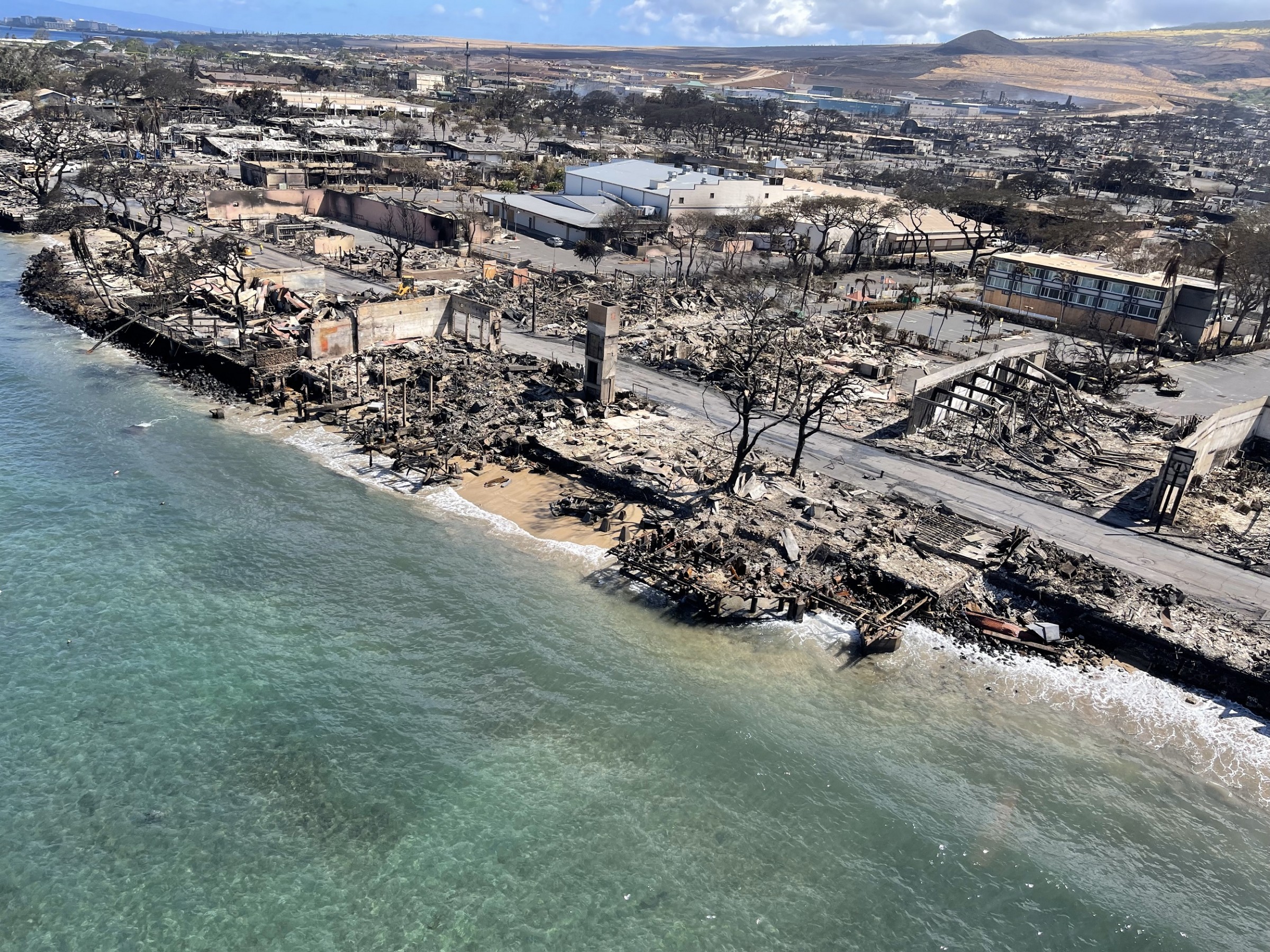The Stream, November 8, 2023: Drought Continues to Cut Ship Capacity at Panama Canal

Fires on the island of Maui in early August burned the historic town of Lahaina. Photo courtesy of Hawai‘i DLNR
YOUR GLOBAL RUNDOWN
- Low water levels are forcing Panama Canal managers to reduce ship transits over next three months to half of normal capacity.
- New report estimates industry lobbying on PFAS-related legislation in the United States.
- The World Meteorological Organization warns that climate change could “reverse decades of progress” to improve public health.
- Local officials reckon it could take years to restore the damaged drinking water system in Lahaina after ferocious fires burned through the town and others on the island of Maui in August.
Acapulco, the resort area in southern Mexico, plots a rebuild in the wake of the destructive Hurricane Otis.
“To support the mechanism, the levees, the pumps and all things that are involved with a hurricane defense system, you have to have more money. Because it’s a continual reinvestment.” — David Waggonner, an architect who designs flood-protection systems for cities.
Hurricane Otis destroyed homes, businesses, and hotels, and caused billions of dollars of property damage after it made landfall on October 25 in southern Mexico. Dozens of people were killed in the Category 5 storm. The resort area of Acapulco was hit especially hard. The big question now: how to rebuild in an era of high-intensity storms?
Reuters reports that experts are recommending stronger building codes, better flood protection, and more precise storm tracking.
Some money for these changes will be available up front. Mexico’s president announced a $3.4 billion recovery fund for Acapulco. But planners warn that such investments are not build-and-ignore. They require consistent maintenance and adjustments.
— Christian Thorsberg, Interim Stream Editor
Recent WaterNews from Circle of Blue
- EPA Restarts Assessment of Health Risks from Nitrate in Water — The agency will evaluate the hazards from agriculture’s primary water pollutant.
- North Dakota Towns Fight Farm Bureau to Keep Water Clean— Tiny Pelican Township gets dragged into national campaign to upend local zoning rules.
The Lead
Devastating fires in early August burned towns across the Hawaiian island of Maui. One major impediment to recovery in the historic town of Lahaina is damage to the water system, Honolulu Civil Beat reports.
John Stufflebean, director of Maui County’s Department of Water Supply, said based on similar fire disasters complete repairs could take two or three years. Benzene and other volatile chemicals have been detected in the water distribution pipes. Contaminants in the air were drawn into the pipe system when it lost pressure during the fire. Individual homes are also contending with melted plastic pipes.
The true extent of the problem is only beginning to be understood. Testing for chemical contaminants in the pipes is in the early stages. Perhaps 2,000 or more water service lines might need to be replaced. Stufflebean estimated that total system repair costs could be $80 million dollars.
In context: New Mexico’s Largest Fire Wrecked This City’s Water Source
This Week’s Top Water Stories, Told In Numbers
$110 Million
Estimated dollars spent by the chemical industry in the last two U.S. election cycles to sway legislation related to PFAS regulation, The Guardian reports. The figure, an estimate that counted documents that mentioned PFAS, comes from an analysis of federal lobbying disclosures by the advocacy group Food and Water Watch. Some 130 PFAS-related bills were introduced in Congress in that time period. Only eight passed.
23
Percent of national health ministries that integrated weather and climate information into their national health surveillance systems. That’s according to a World Meteorological Organization report on climate change and health. The report also found that little climate adaptation finance – roughly 0.2 percent – is dedicated to health. Rising temperatures, more air pollution from dust and smoke, and spreading pathogens threaten to “reverse decades of progress” on public health.
On the Radar
Due to low water levels in Gatun Lake, the Panama Canal Authority will allow fewer cargo ships to cross one of the world’s major commercial trade routes. Drought has depleted the lake, which provides the water for the canal’s locks. As a result, ship access is being severely restricted and the cost of shipping is rising, Reuters reports. In normal conditions, 36 ships per day transit the canal. As of November 3, only 25 will be allowed through the locks. Over the next three months, daily bookings will gradually be tightened. By February 1, the number permitted will be just 18. Year-to-date precipitation is the second-driest since 1950.
More Water News
Reducing Sewage Overflows: The nation’s capital will have cleaner rivers thanks to a recently completed 13.1-mile stormwater tunnel system that will hold excess flows during heavy rains, WTOP reports. DC Water, the city’s water utility, expects the tunnel to reduce sewage overflows into the Anacostia River by 98 percent.
Nutrient Pollution: A University of Georgia study found that the Clean Water Act is not effective in reducing nitrogen and phosphorus in water bodies. Nutrients from non-point sources like farm fields are the leading cause of water pollution nationally.
Brett writes about agriculture, energy, infrastructure, and the politics and economics of water in the United States. He also writes the Federal Water Tap, Circle of Blue’s weekly digest of U.S. government water news. He is the winner of two Society of Environmental Journalists reporting awards, one of the top honors in American environmental journalism: first place for explanatory reporting for a series on septic system pollution in the United States(2016) and third place for beat reporting in a small market (2014). He received the Sierra Club’s Distinguished Service Award in 2018. Brett lives in Seattle, where he hikes the mountains and bakes pies. Contact Brett Walton







Leave a Reply
Want to join the discussion?Feel free to contribute!